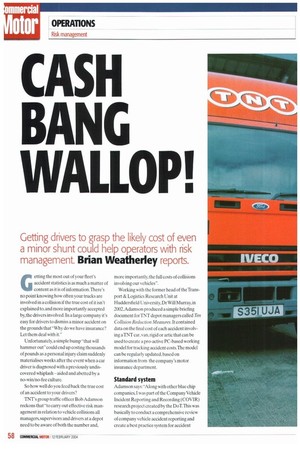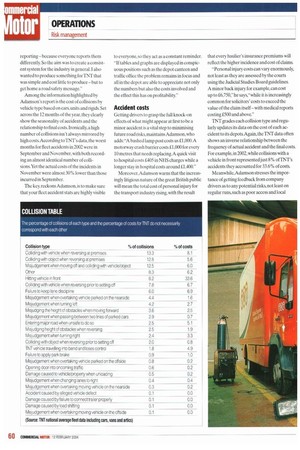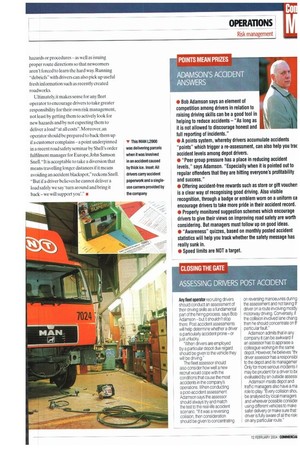CASH BANG WALLOP!
Page 58

Page 60

Page 61

If you've noticed an error in this article please click here to report it so we can fix it.
Getting drivers to grasp the likely cost of even a minor shunt could help operators with risk
management. Brian Weatherley reports.
Getting the most out of your fleet's accident statistics is as much a matter of content as it is of information.There's no point knowing how often your trucks are involved in a collision if the true cost of it isn't explained to, and more importantly accepted by, the drivers involved. In a large company it's easy for drivers to dismiss a minor accident on the grounds that "Why do we have insurance? Let them deal with it."
Unfortunately,a simple bump that will hammer out" could end up costing thousands of pounds as a personal injury claim suddenly materialises weeks after the event when a car driver is diagnosed with a previously undiscovered whiplash aided and abetted by a no-win/no-fee culture.
So how well do you teed back the true cost of an accident to your drivers?
TNT's group traffic officer Bob Adamson reckons that "to carry out effective risk management in relation to vehicle collisions all managers, supervisors and drivers at a depot need to be aware of both the number and, more important ly.the full costs of collisions involving our vehicles".
Working with the former head of theTransport & Logistics Research Unit at Huddersfield University. Dr Will Murray, in 2002.Adamson produced a simple briefing document for TNT depot managers called Ten Collision Reduction Measures. It contained data on the final cost of each accident involving a TNT car, van, rigid or artic that can be used to create a pro-active PC-based working model for tracking accident costs The model can be regularly updated. based on information from the company's motor insurance department.
Standard system Adamson says:-Along with other blue chip companies. I was part of the Company Vehicle Incident Reporting and Recording (COVIR) research project created by the DoT. This was basically to conduct a comprehensive review of company vehicle accident reporting and create a best practice system for accident reporting because everyone reports them differently. So the aim was to create a consistent system for the industry in general. 1 also wanted to produce something for TNT that was simple and cost little to produce-but to get home a road safety message."
Among the information highlighted by Adamson's report is the cost of collisions by vehicle type based on cars, units and rigids. Set across the 12 months of the year, they clearly show the seasonality of accidents and the relationship to final costs. Ironically, a high number of collisions isn't always mirrored by high costs According to TNT's data, the worst months for fleet accidents in 2002 were in September and November. with both recording an almost identical number of collisions.Yet the actual costs of the incidents in November were almost 30% lower than those incurred in September.
The key, reckons Adamson, is to make sure that your fleet accident stats are highly visible to everyone, so they act as a constant reminder. "If tables and graphs are displayed in conspicuous positions such as the depot canteen and traffic office the problem remains in focus and all in the depot are able to appreciate not only the numbers but also the costs involved and the effect this has on profitability."
Accident costs
Getting drivers to grasp the full knock-on effects of what might appear at first to be a minor accident is a vital step to minimising future road risks, maintains Adamson. who adds:"A bashed lamp post costs us £1,000.A motorway crash barrier costs £1,000 for every 10 metres that needs replacing.A quick visit to hospital costs £405 in NHS charges while a longer stay in hospital costs around £1,400."
Moreover, Adamson warns that the increasingly litigious nature of the great British public will mean the total cost of personal injury for the transport industry rising, with the result that every haulier's insurance premiums will reflect the higher incidence and cost of claims.
"Personal injury costs can vary enormously, not least as they are assessed by the courts using the Judicial Studies Board guidelines. A minor back injury for example,can cost up to £6,750," he says,"while it is increasingly common for solicitors' costs to exceed the value of the claim itself -with medical reports costing £500 and above."
TNT grades each collision type and regularly updates its data on the cost of each accident to its depots. Again, the TNT data often shows an inverse relationship between the frequency of actual accident and the final costs. For example, in 2002, while collisions with a vehicle in front represented just 8% of TNT's accidents they accounted for 33.6% of costs.
Meanwhile, Adamson stresses the importance of getting feedback from company drivers as to any potential risks, not least on regular runs, such as poor access and local hazards or procedures as well as issuing proper route directions so that newcomers aren't forced to learn the hard way. Running -debriefs" with drivers can also pick up useful fresh information such as recently created roadworks.
Ultimately, it makes sense for any fleet operator to encourage drivers to take greater responsibility for their own risk management, not least by getting them to actively look for new hazards and by not expecting them to deliver a load "at all costs". Moreover, an operator should be prepared to back them up if a customer complains a point underpinned in a recent road safety seminar by Shell's order fulfilment manager for Europe, John Samson Snell "It is acceptable to take a diversion that means travelling longer distances if it means avoiding an accident blackspot," reckons Snell. "But if a driver believes he cannot deliver a load safely we say 'turn around and bring it back we will support you'." •






























































































































































































